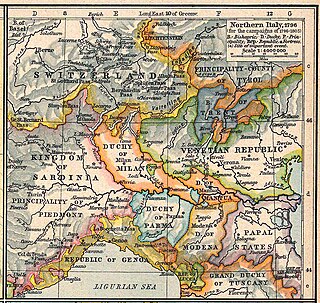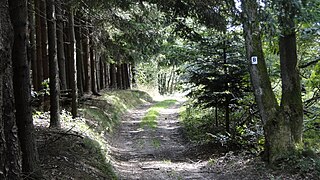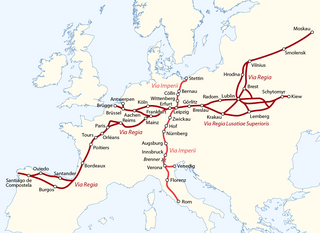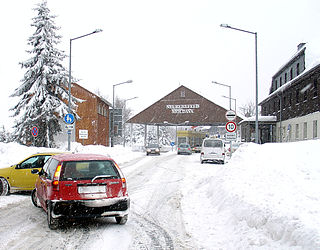 W
WBibulca Way was an old road dating back to the 11th century that used to link up Modena with Lucca and it was part of a much bigger network of roads. It starts where the Dragone River flows into the Dolo River in the La Piana locality and finishes at San Pellegrino in Alpe, a hamlet located on the ridge that separates the Tuscan from the Emilian Apennines. It was also called the Imperial Way due to its high toll that had to be paid in order to use it and that it could host a cart drawn by two oxen one beside the other, a luxury for the time. It has a length of 30 kilometers, starting from a height of 360 metres and arriving at a height of 1,529 metres. Now it is used as an amateur trekking path that runs alongside the Strada provinciale 32MO road and in certain stretches shares the same route.
 W
WThe Birkenhainer Straße is a long-distance hiking trail that follows an ancient trade route through the Mittelgebirge Spessart, in the states of Hesse and Bavaria, Germany. It is 71 km long and leads from Hanau to Gemünden am Main, cutting across the so-called Mainviereck, a large loop of the river Main. The trail follows an ancient trade route which in the Middle Ages was an important road for moving troops and for long-distance trade. The Birkenhainer Straße was a part of the link between Nuremberg and Antwerp. Its origins may lie back as far as the Neolithic period. The name likely derives from a prominent copse of birch trees that used to exist near the road at Geiselbach (Hesse).
 W
WThe Bishop's Road is and ancient road in Saxony, going from Meißen via Dresden to Stolpen.
 W
WThe Old and New Dresden to Teplitz Post Roads are passes over the Ore Mountains and form part of the well-known ancient road system known as the Kulmer Steig, which ran from the Elbe Valley near Dresden over the Eastern Ore Mountains to Teplitz, Bohemia. Today the Saxon section of the Old Dresden to Teplitz Post Road is the best preserved of these historic transport links, complete with old Electorate of Saxony postal milestones.
 W
WThe Eselsweg is a long-distance hiking trail that follows an ancient trade route through the Mittelgebirge Spessart, in the states of Hesse and Bavaria, Germany. It is 111 km long and leads from Schlüchtern in the valley of the Kinzig river to Großheubach on the river Main. The trail follows an ancient trade route on which donkey caravans used to transport salt, thus giving rise to the name.
 W
WIn the Middle Ages, Hellweg was the official and common name given to main travelling routes in Germany. Their breadth was decreed as an unimpeded passageway a lance's width, about three metres, which the landholders through which the Hellweg passed were required to maintain.
 W
WHistoric roads are paths or routes that "have great historical importance or fame". Examples exist from prehistoric times until the early 20th century. They include ancient trackways, tracks, and roads that existed in "the period of history before the fall of the Western Roman Empire" in 476 AD. "The first roads were paths made by animals and later adapted by humans." Many historic routes, such as the Silk Road, the Amber Road, and the Royal Road of the Persian Empire, existed before the Christian era and covered great distances.
 W
WIn medieval times, imperial roads were designated routes in the Holy Roman Empire that afforded protection to travellers in return for tolls collected for the emperor.
 W
WThe Inca road system was the most extensive and advanced transportation system in pre-Columbian South America. It was at least 40,000 kilometres (25,000 mi) long. The construction of the roads required a large expenditure of time and effort.
 W
WThe Inca Trail to Machu Picchu is a hiking trail in Peru that terminates at Machu Picchu. It consists of three overlapping trails: Mollepata, Classic, and One Day. Mollepata is the longest of the three routes with the highest mountain pass and intersects with the Classic route before crossing Warmiwañusqa. Located in the Andes mountain range, the trail passes through several types of Andean environments including cloud forest and alpine tundra. Settlements, tunnels, and many Incan ruins are located along the trail before ending the terminus at the Sun Gate on Machu Picchu mountain. The two longer routes require an ascent to beyond 4,200 metres (13,800 ft) above sea level, which can result in altitude sickness.
 W
WThe Mese was the main thoroughfare of ancient Constantinople. The street was the main scene of Byzantine imperial processions. Its ancient course is largely followed by the modern Divanyolu Avenue.
 W
WThe Old Freiburg to Teplitz Post Road is one of the passes over the Ore Mountains and was a major transport link from the mining town of Freiberg (Saxony) over the crest of the Eastern Ore Mountains to the North Bohemian spa resort of Teplitz, now Teplice.
 W
WThe Ore Mountain passes are crossings and passages over the crest of the Ore Mountains in Central Europe, over which tracks, roads, railway lines and pipelines run from the Free State of Saxony in the Federal Republic of Germany to Bohemia in the Czech Republic and vice versa.
 W
WThe Peć–Mitrovica road (Пећ—Митровица) or Mitrovica–Peć road (Митровица—Пећ) was a road of Serbia in the Middle Ages, an extension of the Ibar road. It was used exclusively for caravans. It was reconstructed by the Ottoman authorities prior to the Balkan Wars but due to insecurity it was abandoned. The Serbian government continued the reconstruction mostly after 1919 and in 1925 it became part of the 650 km long Belgrade–Kotor road. It was further reconstructed in 1928.
 W
WThe Tea Horse Road or chamadao, now generally referred to as the Ancient Tea Horse Road or chamagudao was a network of caravan paths winding through the mountains of Sichuan, Yunnan and Tibet in Southwest China. This was also a tea trade route. It is also sometimes referred to as the Southern Silk Road or Southwest Silk Road, and it is part of a complex routes system connecting China and South Asia.
 W
WVia Imperii was one of the most important of a class of roads known collectively as imperial roads of the Holy Roman Empire. This old trade route ran in a south–north direction from Venice on the Adriatic Sea and Verona in the Kingdom of Italy across the Brenner Pass through Germany to the Baltic coast passing the following cities:Innsbruck in the County of Tyrol Augsburg in the Prince-Bishopric of Augsburg the Imperial city of Nuremberg Bayreuth, Berneck, Münchberg and Hof in the Principality of Bayreuth Plauen, Mylau and Reichenbach in the Vogtland region Zwickau, Altenburg, Regis, Borna, Markkleeberg and Connewitz in the Margraviate of Meissen Leipzig – intersection with east–west Via Regia Wittenberg in Saxe-Wittenberg Cölln/Berlin, capital of Brandenburg Bernau bei Berlin Stettin in the Duchy of Pomerania
 W
WThe Via Regia - is a European Cultural Route following the route of the historic road of the Middle Ages.